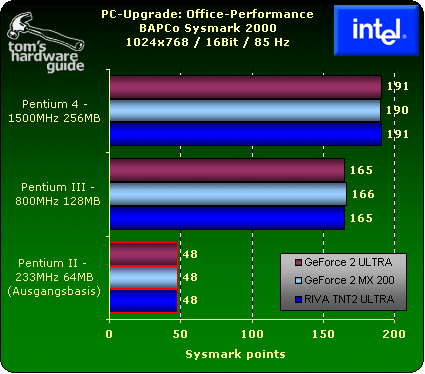A New Lease On Life - How To Make Your PC 5 Times Faster
Improvement In Performance - Up To 500 Percent
All the following results were obtained using the standard BIOS settings. Unlike the majority of our tests, we didn't make any changes to the memory timing in order to eke out the very last spark of performance. Only the AGP bus was run above its specified limit.
Office Performance - Sysmark 2000
A glance at the chart reveals it all - in order to improve office performance, all you need is a faster processor and more RAM. A faster graphics chip doesn't affect 2D performance whatsoever. The PC system upgraded with a Pentium III/800 and 128 MB is almost four times faster than the base configuration with the Pentium II/233 and 64 MB. The difference in performance between the Pentium 4/1500 and the Pentium III/800 is relatively minor. This is a result of the Pentium 4's architecture, which is missing a powerful L2 cache.
MPEG-4 Encoding - Flask Mpeg (Divx)
Converting videos in MPEG-2 format to MPEG-4 has become very popular. Be that as it may, MPEG-4 encoding remains quite a challenge to any system. Creating MPEG sequences gobbles up a lot of memory - which makes the old system with its 66 MHz FSB run very slowly. In comparison, the Pentium 4's high clock speed of 400 MHz keeps frame rates high. In comparison to the last test, we created the video and the audio data streams at the same time. This pushes the refresh rate considerably below the level of results obtained in previous tests. The system we upgraded using a Pentium III performs more than three times as well - in comparison to the base configuration. The Pentium 4/1500 is more than twice as fast as the Pentium III/800 - don't forget, though, that the Pentium 4/1500 works with 256 MB memory.
OpenGL Performance - Quake 3 Arena
Merely installing a powerful graphics card doesn't have much of an effect, as our chart clearly shows. When combined with a GeForce 2 Ultra, our old base system chuffs out a mere 10 frames a second more. In this case, installing a Pentium III/800 has a considerably greater effect. The frame rate increases from 28 to 94.4 frames per second. Installing the GeForce 2 MX200 also produces a sizable increase in performance, while the GeForce 2 Ultra isn't worth its hefty price tag. The Pentium 4 is best able to supply data to the GeForce 2 Ultra - but has no competition in this comparison.
Prices - Upgrade Starting At $137
| Pentium III/800 (Slot 1) with SDRAM | |
|---|---|
| Pentium III 800 MHz / 133 MHz FSB | $107 |
| Motherboard | $0 |
| 1 x 128 MB SDRAM | $30 |
| Total | $137 |
| Pentium III/800 with Slot Adapter and SDRAM | |
| Pentium III 800 MHz / 133 MHz FSB | $107 |
| FCPGA Adapter | $10 |
| Motherboard | $0 |
| 1 x 128 MB SDRAM | $30 |
| Total | $147 |
| Pentium III/800 with Motherboard and SDRAM | |
| Pentium III 800 MHz | $107 |
| Motherboard (Asus CUSL2) | $110 |
| 1 x 128 MB SDRAM | $30 |
| Total | $247 |
| Pentium 4/1500 with Motherboard and RIMM | |
| Pentium 4 1500 MHz inklusive 2 x 128 MB RIMM | $200 |
| Motherboard (Gigabyte GA-8TX) | $160 |
| Total | $360 |
| Graphics Card (Extra) | |
| GeForce 2 MX200 (Abit Siluro) | $75 |
| GeForce 2 Ultra (Sparkle SP6900T) | $300 |
This chart lists our three different upgrades. The cheapest version consists of only purchasing the Pentium III/800 and RAM. Anyone needing a Socket adapter in addition has to pay at least $10 more. If the motherboard is too old for an upgrade, then the cost of purchasing a new motherboard has to be added to the equation. In this case we've used the Asus CUSL2 (Intel 815E chipset) as a basis. This motherboard is available for approx. $110. Upgrading with the Pentium 4 is a real non-issue, since the cost of doing so is astronomical. The Pentium 4 configuration has only been included for those users that want to have the most current Intel system as a point of reference. In case the graphics card in the system is too slow, we've also included both cards used in the tests.
Conclusion - Selective Upgrade Very Cheap
First things first - upgrading with a Pentium 4 isn't worthwhile. The costs incurred are much too high and the gain in performance is minimal in relation to the money spent. This situation is very different for the Pentium III/800 - it is currently very inexpensive and also available in a Slot version. SDRAM is cheap - at present, 128 MB costs less than $30 - and it improves performance dramatically in comparison to the base system with 64 MB. For a lot of older PC systems, only a CPU and RAM upgrade can significantly increase performance. Gamers will have to get a current 3D graphics card in addition - the thickness of your wallet will decide whether it'll be the GeForce 2 MX200 or the GeForce 2 Ultra. The decision isn't quite as easy if you have to exchange not only the processor and the RAM but also the motherboard. In that case, you can also switch gears and get an inexpensive AMD Athlon system. What improvements in performance can be reached using an old AMD K6-2 system on a Socket 7 as a basis? This will be the topic of our next article, in which we will focus on the AMD platform.
Get Tom's Hardware's best news and in-depth reviews, straight to your inbox.
Current page: Improvement In Performance - Up To 500 Percent
Prev Page Installing The New Components, Continued

